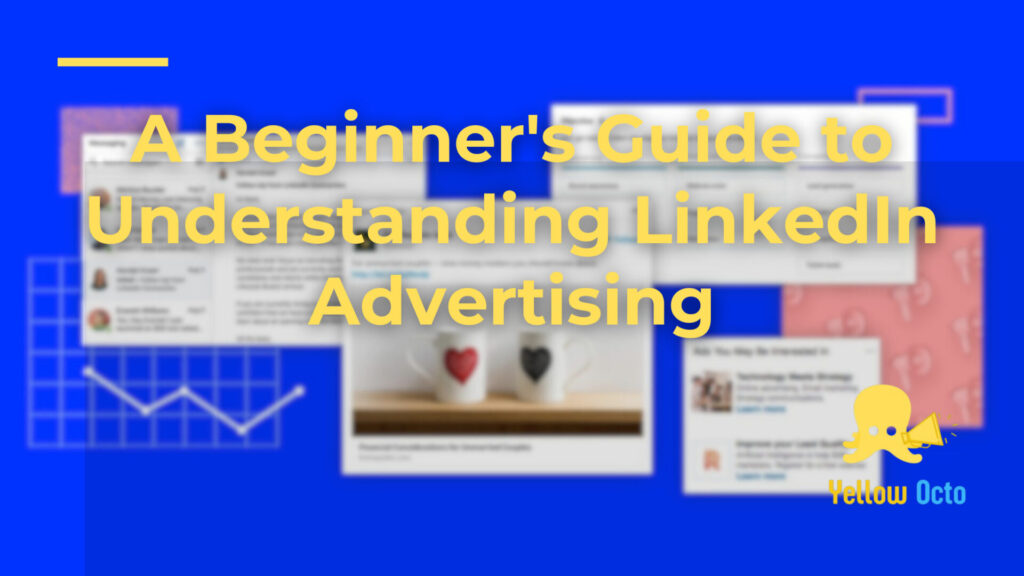 A Beginner’s Guide to Understanding LinkedIn Advertising
A Beginner’s Guide to Understanding LinkedIn Advertising
1. Introduction
LinkedIn has become a powerful platform for professionals and businesses to connect, network, and promote their products and services. With its growing user base and extensive targeting options, LinkedIn advertising has emerged as a valuable tool for digital marketing solutions.
Whether you’re a coach looking to attract new clients or an agency seeking effective lead generation strategies, understanding LinkedIn advertising is essential in today’s competitive market.
Want to generate leads through your LinkedIn ADs? Schedule a free call with Yellow Octo!
This beginner’s guide will equip you with the knowledge and insights needed to navigate the world of LinkedIn ads, maximize your reach, and achieve your business goals.
2. The Basics of LinkedIn Advertising
LinkedIn advertising offers a wide range of advertising options to help you reach your target audience effectively. In this section, we’ll cover the basics of LinkedIn advertising to give you a solid understanding of how it works.
The first step in launching your LinkedIn ad campaign is setting up your ad account. You can easily create an account by visiting the LinkedIn Campaign Manager and following the prompts to set up your campaign objectives, budget, and targeting preferences.
Once your ad account is set up, you can start creating your LinkedIn ads. LinkedIn offers various ad formats including sponsored content, text ads, and sponsored InMail. Each ad format has its own unique benefits, so it’s important to choose the one that aligns with your goals and target audience.
When it comes to targeting, LinkedIn provides powerful options to ensure your ads reach the right people. You can narrow down your audience based on factors such as job title, company size, industry, location, and more. This level of targeting allows you to deliver your message directly to the professionals who are most likely to be interested in your products or services.
3. Setting Up Your LinkedIn Ad Campaign
Setting up your LinkedIn ad campaign is a crucial step in ensuring the success of your advertising efforts. In this section, we will guide you through the process of setting up your campaign in detail.
To start, log in to your LinkedIn Campaign Manager and click on the “+ Create Campaign” button. You will be prompted to choose a campaign objective from a list of options such as brand awareness, website visits, or lead generation. Select the objective that aligns with your marketing goals.
 Next, you will be asked to set a budget for your campaign. LinkedIn allows you to set a daily or total budget, giving you control over how much you spend. It is important to consider your advertising goals and the size of your target audience when setting your budget.
Next, you will be asked to set a budget for your campaign. LinkedIn allows you to set a daily or total budget, giving you control over how much you spend. It is important to consider your advertising goals and the size of your target audience when setting your budget.
After setting your budget, you will move on to defining your target audience. LinkedIn provides a range of targeting options to help you reach the right professionals. You can narrow down your audience based on job title, industry, location, and more. Take your time to carefully select the criteria that will best align with your target market.
Lastly, you will need to create your ad creative. Whether you choose sponsored content, text ads, or sponsored InMail, make sure your ad delivers a clear and compelling message. Use eye-catching visuals, concise copy, and a strong call-to-action to entice your audience to take action.
Once you have set up your campaign, make sure to continuously monitor and optimize your ads to ensure they are performing well.
4. Targeting the Right Audience
Targeting the right audience is essential for the success of your LinkedIn ad campaign. LinkedIn provides a wide range of targeting options to help you reach the professionals who are most likely to be interested in your product or service.
When defining your target audience, consider factors such as job title, industry, company size, location, and more. The more specific and targeted your audience is, the higher the chances of your ads resonating with them.
LinkedIn also offers advanced targeting options, such as retargeting website visitors or creating lookalike audiences based on your existing customer base. These options can further narrow down your audience and increase the effectiveness of your ads.

Remember to regularly review and analyze the performance of your ads to ensure they are reaching the right audience. Monitor click-through rates, engagement metrics, and conversions to assess the effectiveness of your targeting and make necessary adjustments.
By targeting the right audience, you can maximize the impact of your LinkedIn ad campaign and achieve your marketing goals. In the following section, we will explore the different ad formats you can choose from to make your ads stand out.
- Designing Effective LinkedIn Ads
Once you have defined your target audience, the next step is to create compelling ads that will capture their attention and drive engagement. LinkedIn offers several ad formats that you can choose from to make your ads stand out.
- Sponsored Content: This ad format appears directly in the LinkedIn feed, making it highly visible to your target audience. You can use images, videos, or carousel formats to showcase your brand or promote specific products or services.
- Message Ads: This format allows you to send personalized messages directly to LinkedIn members’ inboxes. It’s a great way to engage with your audience on a one-on-one basis and establish a more personal connection.
- Text Ads: These are simple, text-only ads that appear on the right-hand side of the LinkedIn feed or on the top of the LinkedIn search results page. While they may not be as visually appealing as other formats, they can still be effective if you craft compelling copy and use attention-grabbing headlines.
- Dynamic Ads: These ads are highly personalized and can be tailored to each individual LinkedIn member based on their LinkedIn profile information. They can help you effectively target professionals with relevant content and increase engagement.
When designing your ads, remember to keep them visually appealing, concise, and relevant to your target audience. Use eye-catching visuals, compelling headlines, and clear call-to-actions to maximize their effectiveness.
6. Managing and Optimizing Your LinkedIn Ads
Creating compelling ads is just the first step in running successful LinkedIn ad campaigns. To ensure you’re getting the best results, it’s important to actively manage and optimize your ads throughout their lifecycle.
One key aspect of managing your LinkedIn ads is monitoring their performance. LinkedIn provides comprehensive analytics and reporting tools that can help you understand how your ads are performing and make data-driven decisions.
Regularly review key metrics such as click-through rates, engagement rates, and conversions to gauge the effectiveness of your ads. If certain ads are underperforming, consider making adjustments to the visuals, copy, or targeting criteria.
Another important aspect of optimization is A/B testing. Experiment with different variations of your ad creative and targeting parameters to identify what works best for your target audience. This can be done by creating multiple ad sets and analyzing their performance over time.
Furthermore, don’t forget to continuously refine your targeting parameters. LinkedIn offers a range of targeting options that allow you to reach specific professional demographics, industries, job titles, and more. Regularly assess and adjust your targeting strategy to ensure that your ads are reaching the right audience.
Lastly, don’t be afraid to optimize your budget. Monitor your ad spend and allocate your budget towards the campaigns that are generating the best results. This may involve increasing the budget for high-performing ads or pausing underperforming ones.
By actively managing and optimizing your LinkedIn ads, you can ensure that your advertising efforts are yielding the best possible results.
7. Measuring Success and ROI
One of the most important aspects of running LinkedIn ad campaigns is measuring their success and return on investment (ROI). By tracking key metrics and analyzing the data, you can determine whether your advertising efforts are delivering the desired outcomes.
LinkedIn provides comprehensive analytics and reporting tools that can help you measure the performance of your ads. Some key metrics to track include impressions, clicks, click-through rates (CTR), engagement rates, and conversions. These metrics will give you insights into the effectiveness of your ads and help you make data-driven decisions.
 In addition, it’s important to set clear goals and objectives for your LinkedIn advertising campaigns. Are you aiming to generate leads, increase brand awareness, or drive website traffic? By defining your goals, you can align your ad strategies and evaluate their impact on your overall marketing objectives.
In addition, it’s important to set clear goals and objectives for your LinkedIn advertising campaigns. Are you aiming to generate leads, increase brand awareness, or drive website traffic? By defining your goals, you can align your ad strategies and evaluate their impact on your overall marketing objectives.
ROI is another important metric to consider when assessing the success of your LinkedIn ad campaigns. By comparing the cost of running the ads to the revenue or value they generate, you can determine the profitability of your advertising efforts. Calculating ROI can help you understand the monetary value you’re gaining from your LinkedIn ads and make informed decisions about resource allocation.
To accurately measure ROI, it’s crucial to track conversions and attribute them to specific ad campaigns. Use LinkedIn’s conversion tracking feature or integrate your LinkedIn ads with your website analytics tool to gain visibility into the actions users take after interacting with your ads.
Regularly review your metrics, evaluate your goals, and assess your ROI to identify areas for improvement in your LinkedIn advertising strategy. By continuously measuring and optimizing your ads, you can ensure that you’re maximizing the return on your advertising investment.
8. Conclusion
In conclusion, understanding how to measure the success of your LinkedIn ad campaigns is crucial for optimizing your advertising efforts. LinkedIn provides a range of analytics and reporting tools that allow you to track key metrics such as impressions, clicks, CTR, engagement rates, and conversions. By setting clear goals and objectives, you can align your ad strategies and evaluate their impact on your overall marketing objectives. Additionally, calculating ROI is essential for determining the profitability of your advertising efforts. By tracking conversions and attributing them to specific ad campaigns, you can accurately measure the monetary value you’re gaining from your LinkedIn ads. Regularly reviewing your metrics, evaluating your goals, and assessing your ROI will help you identify areas for improvement in your LinkedIn advertising strategy. So, stay tuned for the final section of this guide where we’ll explore some advanced strategies and tactics that can take your LinkedIn advertising to the next level and help you achieve even greater success.

